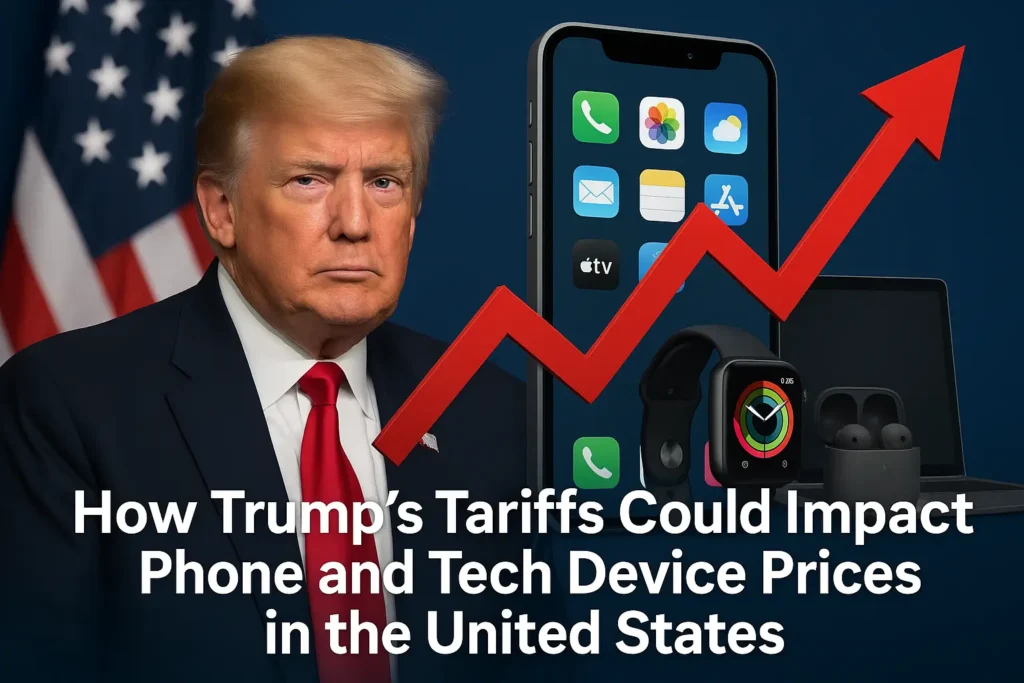In the evolving landscape of U.S. politics and global trade, one of the most closely watched areas remains the impact of trade policies on consumer electronics. With former President Donald Trump making headlines again with renewed promises to impose stricter tariffs on imports—especially from China—many Americans are asking: What will happen to the prices of smartphones and tech gadgets?
This article explores the potential consequences of Trump’s proposed tariffs on phones and other tech devices in the U.S., examining economic, supply chain, and consumer perspectives.

🔹 Understanding Tariffs and Their Purpose
A tariff is a tax imposed by a government on imported goods. The primary purpose of tariffs is to make foreign products more expensive, thereby encouraging consumers to buy domestic alternatives. However, in the tech world—especially when it comes to smartphones, laptops, tablets, and other gadgets—most of these products are either fully made or assembled abroad, often in China, Taiwan, or Southeast Asia.
Therefore, imposing tariffs on these goods could significantly influence their retail prices in the U.S. market.
🔹 Trump’s Tariff History and Current Proposals
During his first term, President Trump imposed multiple rounds of tariffs on Chinese goods as part of a broader strategy to reduce the U.S. trade deficit and push back against what he described as unfair trade practices.
In his 2024 campaign rhetoric and interviews, Trump has suggested:
- Reinstating and expanding tariffs on Chinese imports.
- Introducing a universal tariff of 10% on all imports, regardless of origin.
- Targeting tech-related imports more specifically, citing concerns over national security and dependency on China.
While these policies are not yet in effect, their mere suggestion has already triggered concern among tech manufacturers, retailers, and consumers.
🔹 How Will Tariffs Affect Phone Prices?
1. Higher Production Costs
Most smartphones from brands like Apple, Samsung, OnePlus, Xiaomi, and Google are either produced or assembled in China. If a 10% or higher tariff is imposed:
- The cost to import these devices into the U.S. would increase.
- Companies will likely pass a portion (or all) of this additional cost to consumers.
- This means higher prices for new smartphones, potentially by $50–$200 per device.
2. Impact on Flagship vs. Budget Phones
- Flagship devices like the iPhone 15 Pro Max or Samsung Galaxy S24 Ultra could see price hikes between $100–$300 depending on component sources.
- Budget and mid-range phones, which often rely even more on low-cost manufacturing in Asia, may become less competitive in the U.S. market or simply more expensive for consumers looking for value.
🔹 Broader Impact on Tech Devices and Accessories
Tariffs won’t only affect smartphones. Here’s how other tech products may be impacted:
| Product Category | Potential Impact |
|---|---|
| Laptops & Tablets | Brands like Lenovo, HP, and even Apple could raise prices to offset costs. |
| Smartwatches & Fitness Bands | These are mostly made in China, so price hikes are likely. |
| Headphones & Earbuds | Budget options from Asia could become less viable. |
| Phone Accessories (cases, chargers, etc.) | Expect significant markups, especially for bulk imports sold online. |
Even gaming consoles such as PlayStation, Xbox, and Nintendo Switch may be affected, since they are assembled in Asia and rely heavily on global supply chains.
🔹 Reactions from Tech Companies
Companies like Apple, Google, and Samsung have previously warned about the negative effects of tariffs on innovation and pricing. Some may:
- Increase U.S. prices while keeping global pricing stable.
- Shift manufacturing to countries like India or Vietnam to avoid tariffs—though this takes time and capital.
- Absorb part of the cost, which could reduce their profit margins and R&D budgets.
🔹 Consumer Behavior: What to Expect
As prices rise, consumer behavior will likely shift, including:
- Delaying device upgrades, keeping older phones longer.
- Purchasing refurbished or used tech rather than buying new.
- Switching to less expensive brands or models that are not as affected by tariffs.
This could slow down the overall tech market growth and impact sales for retailers and manufacturers alike.
🔹 Long-Term Implications for the U.S. Tech Ecosystem
While the short-term effect is higher prices, the long-term outcomes could include:
- Increased domestic manufacturing—though this is expensive and may not be feasible for all tech products.
- Greater investment in alternative trade partnerships with countries outside China.
- Pressure on U.S.-based startups and smaller companies, which rely on affordable global supply chains.
These developments could reshape how tech is produced, sold, and consumed in the U.S. for years to come.
🔹 Final Thoughts
Trump’s proposed tariffs could bring substantial changes to the U.S. tech market, particularly in terms of smartphone and device pricing. While intended to promote domestic industry and national security, the short-term effect on consumers would likely be higher costs and fewer choices.
As the political landscape evolves, so too will the strategies of tech companies, trade negotiators, and consumers. For now, it’s crucial to stay informed, watch for official policy changes, and understand how global trade dynamics affect your next tech purchase.
Author’s Note:
This article is written with the intention to inform and does not endorse any political stance. It is based on publicly available information and economic analysis as of April 2025.